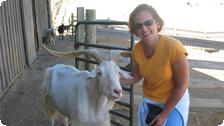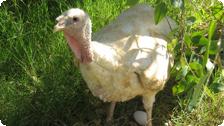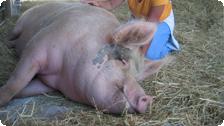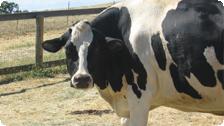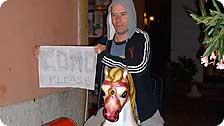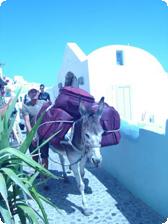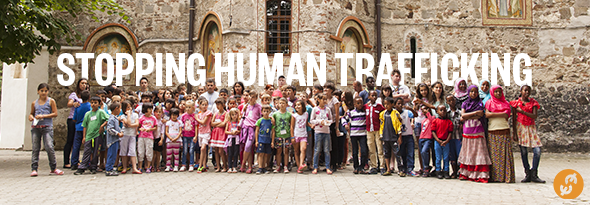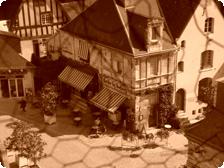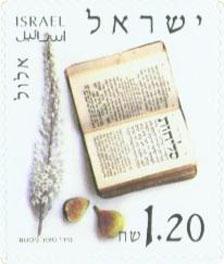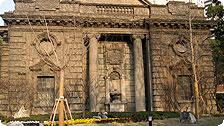Orland, California: Udder Sanctuary
by Jennifer Anthony
A few months ago, I purchased a book entitled 101 Things to Do Before You Die by British author Richard Horne. Though morbid-sounding, it’s actually a fun, cheeky book that contains an array of must-do activities, ranging from the feasible (“read all the literature ‘classics’”) to the rather silly (“meet someone with your own name”) to the fabulously expensive (“visit every country”), to the sexy (“get backstage and get off with a rock god.”).
I got a little thrill discovering that I’d actually done some of the activities (“skydive,” “be a human guinea pig,” and others I won’t admit here) and was able to slap a star sticker (which come with the book) on those pages. But apparently I couldn’t die yet; I still had some unfinished business. One such task was milking a cow. This seemed like a fun, and fairly easy to boot.
I am thirty-five years old. How is it that I have never milked a cow? I live in California, the land of happy cows! I drive up and down scenic Highway 280 every day, zooming past battalions of them, munching contentedly on their cud, lazing around under trees, or marching back over hill and dale at sunset. I go to a farm on a Los Altos reserve so regularly that I know the cow’s name. But alas, Michelle and I have always stayed on opposite sides of the fence.
I’m a researcher, so I did what I do every day: I started to investigate. I asked friends first: Ever milked a cow? I was met with blank, pitying looks. When I explained about the to-di list, one friend asked, But isn’t that list very subjective? Why don’t you make your own?
She had a point, but Horne’s book doesn’t preclude one from doing other things. In fact, there’s an extra page added for a person’s individual accomplishments, and there’s even suggestions for possible 102nd feats (“steal your own Christmas tree,” “rule the world”). But I was fixated on the cow, and couldn’t be swayed. I’m a little bullish like that.
I turned to my computer, in a quandary as to the key words I’d type into Google. Cow milking? I suppose I expected an extensive list of nearby farms where I could befriend some bovines. What the hell, I was even willing to travel a bit of a distance—that’s how flexible I was in my quest. But the search yielded some rather surprising results.
The first discovery was that not everyone believes that California cows are happy. In fact, some people would argue that the lives of most cows are quite dolorous—they’re forced to suffer cramped conditions and treated as products, not lives. I suddenly felt guilty, immeasurably shallow, and like a bit of a sell-out: I, who loved animals, had neglected to look at the big picture.
Yet even the most die-hard advocates couldn’t say that every cow leads a miserable existence. Forced to look at the situation more objectively, I had to consider the farmer’s perspective as well. There are certainly many kind and noble ranchers who do a necessary job for omnivores such as myself.
But my task wasn’t necessary—it was fun and frivolous, even though I had, of course, silently vowed to be gentle and understanding if I stumbled into a cow-milking opportunity. And then I found what seemed to satisfy all the criteria—a farm sanctuary. A sanctuary! No animal could possibly be mistreated in such a place. Since they gave tours, I called and left a voice mail. I was direct: I’d like to visit your farm. And would it be possible to milk a cow while I’m there?
A staff member from the Sanctuary called back and left me a voice mail. We’d love for you to visit and we do have cows, the message began. I was ecstatic! But she continued: Although we do not milk our cows, or our goats, or use our animals for any sort of product. Our animals have been rescued from horrible situations and come here to live out the rest of their lives in peace. And we’re all vegans here, so I don’t feel comfortable recommending someplace else. The message was very long and quite detailed, yet gentle and subtle. She didn’t address me like I was a dolt, and her message was neither inflammatory nor militant. It was, in fact, the sort of calm, intellectual, informed message that provokes someone to think.
It was also the type of message that would make someone jump into their car without thoroughly reading a website and drive three hours, alone, to the foothills of the coastal mountain range near Orland, past Chico. I would stay overnight in the nearby hotel, pay my discounted price for mentioning the Sanctuary, and drive over bright and early on Sunday morning for the 10:00 a.m. tour.
But when I checked into the motel at 3:33 p.m., the front desk clerk looked befuddled. Are you going today? You know the Sanctuary closes at four, right, and it’s closed on Sundays?
What?
The temperature was already tickling one hundred degrees, and my own temperature was nearly catching up. The Sanctuary was about a fifteen-minute drive from the hotel, along a winding country road. I sped out of the parking lot, took the country curves like Schumacher would if he drove a Civic.
I arrived at the Farm at 3:55, tried to visually gulp all three hundred acres of it in. Barns off to the right, golden pastures before me, a gift shop and office labeled “The People Farm” to the left. Sweaty and pinkish-purple as a turnip, I ran inside where a young woman and man sat, chatting. Both looked up, smiled tentatively. I was a sight—frizzy hair and, come to find out later, lipstick on my front teeth. I knew what they were thinking: We’ve got a live one here.
They explained that the last tour had been at 3:00 and the Farm closed at 4:00. I nodded, a little breathless, and said, softly, Please, could I just look around for a few minutes? I’ve driven three hours from the Bay Area, not realizing you weren’t open on Sundays. It’s my fault; I didn’t read the website thoroughly.
They glanced at each other, silent. A muted cow moo sounded from outside.
Well, if you wouldn’t mind an informal tour, that would be fine, the woman said, pointing at the man. It wouldn’t be official, but he could show you around, have you meet all the animals. He volunteers here.
I stared, dumbfounded by the kindness.
Want some water to bring along? the man asked. It’s hot out there.
They weren’t kidding about it being a sanctuary.
And we set out. First stop, the cow pasture. Toffee and white Brahmans and black Anguses sauntered around. And there, cozying up to a fence, stood an immense dairy cow, her slick white coat providing a backdrop for pools of black like countries on a map. My hand rose of its own volition to pet her, slid across her smooth back, bumped along the angles of bone before her shoulder. I stole a peek at her udder and smiled as my guide pointed out various cows in the pasture by name and relayed their stories.
Next we visited the pig and duck ponds, the sprawling bunny hutch with indoor pyramids of hay and an outdoor romping ground, the sheep and goat barn, and the turkey quarters. For the first time in my life, I stood inches away from a live turkey and was able to pet his smooth feathers and bumpy waddle. I tried to dole out equal amounts of scratches and rubs to two goats who vied for my attention, one of whom nudged me very gently with his horns when I lost focus.
My guide introduced me to each animal like he would a dear friend, sharing both their virtues and their faults: an affectionate but unabashedly jealous goat, a charming and timid turkey, a flock of feral sheep who would always be wild. As he led me to the pigs, he noted how they were in good moods that day.
As well they should have been, because the pigs had found the ideal spot—passed out cold in front of enormous fans. I hunkered down in front of one, gave her a hug. I had to come clean. I’m not a vegan, I told my guide. But as ridiculous as this sounds, I did give up eating pork after I saw the movie Babe.
I expected him to laugh at me, as you are undoubtedly doing right now.
That’s great, he said, with a warm smile. And it turns out James Cromwell, who starred in the movie, is one of our biggest supporters.
No, I’ve never milked a cow. But I have pet one. And I’ve hugged a pig, and tickled a turkey. And I’m trying to change a few eating habits.
Item #102: Udder Sanctuary.
* * * *
To learn more about the farm, visit www.farmsanctuary.org. Note that there are two sanctuaries, one in Northern California and another in Upstate New York. California visitors can stay at the Orland Inn at a discounted rate (www.orlandinn.com), or in a cabin on the farm’s property.
For more agriculture adventures for groups and individuals, try farm tours in Frenso County. Four innovative farmwomen, will be offering farm tours every Saturday this June filled with homegrown hospitality, education, country fun, and tasty treats. Variations of the tour will operate year-round. For more information call (800) 579-8043.
Jennifer Anthony was raised in the Bay Area’s ‘burbs, and although she’s never had cows, she has shared her homes with an eye-popping variety of pets, including birds, reptiles, dogs, fish, cats, guinea pigs, and chickens.
Discover more from Tango Diva
Subscribe to get the latest posts sent to your email.
